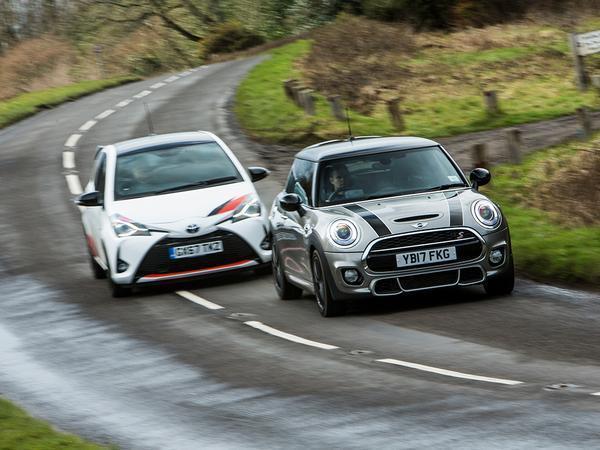Toyota Yaris GRMN vs Mini Cooper S Works 210
Can Toyota really take it to the segment's best with its supercharged Yaris?

Yes, really. Despite there now having been more than 15 years of 'new' Cooper S Minis - plus the various GP, Challenge, and Works models - there's still a hint that cars like the 210 aren't on many hot hatch shortlists. Too much style (or attempts at it) and not enough substance would appear to be the general consensus, however far from the truth that may be. And while the F56 generation Mini hasn't been an unqualified triumph, those who dismiss this particular one for whatever reason should reconsider. Because it's absolutely fab.

The Works 210's talent lies in a very clever combination of small BMW traits along with some brilliant hot hatch ones. It's grown up but it's also exciting, and one is never allowed to dominate the other. So it's agile and eager and properly fast enough, yet with the damping quality, refinement and sufficiently easy going nature to cover a lot of miles. It's exactly what you want from a mature, modern Mini.

Moreover, those who believed that Japanese performance cars were no longer raw and no longer focused will find a lot to enjoy in the Toyota. It demands the driver's attention, whether you want to give it or not, the Torsen limited-slip diff dragging you away from corners as effectively as the brakes have slowed you into them - a drive will never be forgettable, that's for sure.

While the Mini could never be described as truly supple in either of its (optional) damper settings, it has a B-road poise that eludes the Toyota, which in turn gives you the confidence to carry more speed and establish a rhythm. Moreover it's the Mini that seems to have the more neutral chassis balance, the Toyota's dynamics largely dictated by its front end. Yet thanks to GRMN's awkward driving position and slight hesitation in the first few degrees of steering - the former could of course compound the sensation of the latter - it's the Mini that has the more incisive turn in as well. The 'maximum go-kart feel' isn't entirely marketing tosh...

That it will also settle down to a more relaxed cruise than the Toyota, in a vastly more welcoming interior, means the conclusion of this twin test hopefully won't take too much deciphering. Let's not lose sight, however, of what Toyota has achieved here, and what the GRMN represents. Toyota didn't have to make fast cars again; it could have been content making millions of hybrids and crossovers. But it saw the worth in a tangible link to motorsport, the brand-building value of halo models and the relevance of the enthusiast market, which deserves to be applauded. Furthermore the Yaris is not some cynical 'motorsport special', it's a car brimming with intent and purpose and, just as validly, potential for the future. Lots of the reasons for why the Mini wins this test stem from the whole car being devised with a Cooper S in mind, from ground up. The GRMN team was always working with one hand behind its back because the Yaris was not, and its origins can never be fully escaped. Arguably that makes the car more of a success than originally suggested. Making a hot hatch from a Yaris is like making a hurdler from my Nan, because however much expertise you throw at it the architecture is fundamentally unsuited.

Mini deserves credit here for finally realising the potential in the F56 Cooper S; if Toyota and GRMN can tap into its own potential with a more suitable base product, however, then we could have some superb performance cars on the horizon.
| Toyota Yaris GRMN - Specifications | |
|---|---|
| Engine | 1,798cc, supercharged 4-cyl |
| Transmission | 6-speed manual, front-wheel drive |
| Power (hp) | 212@6,800rpm |
| Torque (lb ft) | 184@4,800rpm |
| 0-62mph | 6.4 sec |
| Top speed | 143mph |
| Weight | 1,135kg |
| MPG | 37.7 (NEDC combined) |
| CO2 | 170g/km |
| Price | £26,295 (and £26,295 as tested!) |
| Mini Cooper S Works 210 - Specifications | |
|---|---|
| Engine | 1,998cc, turbocharged 4-cyl |
| Transmission | 6-speed manual, front-wheel drive |
| Power (hp) | 210@4,700rpm |
| Torque (lb ft) | 221@1,250rpm (!) |
| 0-62mph | 6.9 sec |
| Top speed | 144mph |
| Weight | 1,220kg (EU, with driver) |
| MPG | 47.1 (NEDC combined) |
| CO2 | 139g/km |
| Price | £19,994.40 (for standard Cooper S. As tested £28,344.40 comprising £475 for Melting Silver metallic paint, £300 for Mini active from 12/06/17 to 11/06/20, £1,695 for Works enhanced kit, £75 for John Cooper Works sport leather steering wheel, £375 for variable damper control, £80 for black bonnet stripes, £120 for Anthracite roof lining, £220 for sun protection glass, £215 for front seat heating, £2,710 for Mini hatch tech pack, £2,000 for Chili pack for JCW sports pack and £85 for LED headlights with extended contents). |
Whilst they’re all sold I would like to see Toyota Yaris GRMN vs Abarth 595 Competizione or 695 biposto as delivery mileage cars are the same price.
Gassing Station | General Gassing | Top of Page | What's New | My Stuff









